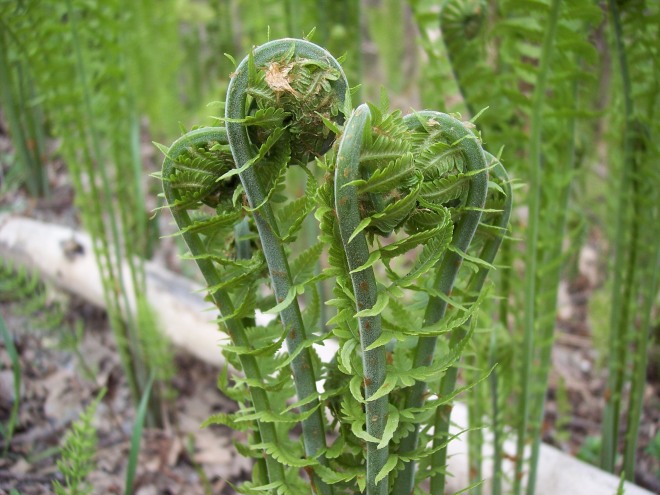Equipped for Survival
The Earth is inhabited by a great variety of living organisms in a seemingly endless array of shapes and forms. From single-celled bacteria to giant sequoia trees, millipedes to moose, living things have different structures and behaviors that allow them to meet their basic needs. A hummingbird’s long thin bill lets it reach the nectar deep inside a trumpet flower. A grass plant grows from the base of its stems rather than at the tips so it can withstand grazing or fire without harm. Looking for the connections between structure and function is an important concept in biology and can be as exciting as unraveling a mystery.
Each kind of bird or spider, tree or fern, has a particular lifestyle and habitat. Organisms differ in ways that help them to survive – to avoid predation, to gather food and water, to find a mate and have young, or make and disperse seeds. In every group of organisms we find both shared characteristics and others that are unique to each species. All spiders have eight legs and spinnerets that produce silk – and yet there are many kinds of spiders, each suited to its particular way of life. Garden spiders use silk to weave a web and trap-door spiders use it to line their burrows. All birds have beaks, wings, and a covering of feathers, but swallows have wide, gaping beaks for catching insects as they fly, and herons have long, sharp beaks for spearing fish.
Inherited traits like bird beaks, spider silk and the growth habits of grasses are examples of adaptations, special structures or behaviors that help an organism to survive. When certain characteristics provide advantages in surviving and reproducing, these favorable traits increase in future generations through natural selection. Adaptations evolve over time, making each species well-suited to its environment and way of life.
In these units we’ll compare different organisms as we think about how physical and behavioral characteristics relate to important functions in their lives and how they affect each organism’s ability to live and grow and have offspring.
In Spiders – Wed-builders and Wanderers, we take a close look at spiders, noting special structures like spinnerets, pedipalps, and fangs. We’ll compare spiders that trap their food in webs with those that stalk their prey. Tremendous Trees lets us see that plants have adaptations as well as animals. We learn how the many parts of these towering organisms, from roots to crown, sapwood to leaves, contribute to their survival. In Grasses and Grains we consider how a grass plant is able to endure high winds, hold onto slippery slopes, and grow back after being mowed or grazed. We notice the lack of showy features in the flowers of these wind-pollinated plants, and consider the importance of grains to us and other animals.
Predators and Prey compares the physical and behavioral characteristics of animals that hunt with those that are prey. We meet some local animals and model how they interact, to help us understand how predators and prey are important to each other. In Skull Sleuthing we examine the different challenges faced by herbivores, carnivores, omnivores, and insectivores in obtaining and eating their food. By studying the structure of mammal skulls we learn how teeth and eye position give clues about an animal’s diet and way of life.
Birds of a Feather looks at the many adaptations unique to birds. We see how the shape and size of beaks and feet are connected to a bird’s diet and habitat, and how the structure of feathers differs depending on their different functions. The distinctive adaptations of owls – eyes, ears, feathers, feet, and digestive system – set them apart from other birds, and in Calling All Owls we see how these relate to their lives as nighttime predators. Owl pellets give us important clues about their diet, while learning to recognize their calls helps us discover what owls live near us.
In Daunting Defenses we consider how both plants and animals have evolved structures and habits, last lines of defense, to protect them from being eaten. In Beavers and Muskrats we discover many special adaptations connected to the aquatic lives of these animals, noticing similarities in these two different mammals that occupy the same kind of habitat. Finally, in The Buzz on Bees we look at the amazing adaptations of a social insect, the honeybee, including their symbolic dance language, an innate behavior that helps to coordinate foraging. We observe differences among the three castes in a hive and find that each has traits related to its particular jobs, demonstrating once again the relationship between structure and function.
As we encounter plants and animals inside and outside the classroom, we’ll consider how each is equipped for survival. We’ll explore the characteristics of organisms, look for the connections between form and function and marvel at the wonderful diversity of life on Earth.
* * * * *
Next Generation Science Standards and Common Core State Standards
The units and activities in Structure and Function support the three Dimensions of the Next Generation Science Standards. Together the lessons in this concept give children opportunities to engage in the Science and Engineering Practices (Dimension I) and to reflect on the Cross-cutting Concepts (Dimension II) as identified in the Next Generation Science Standards.
The monthly topics also address Disciplinary Core Ideas (Dimension III) in Life Sciences (LS1: From Molecules to Organisms: Structures and Processes, LS2: Ecosystems: Interactions, Energy, and Dynamics, LS3: Heredity: Inheritance and Variation of Traits, and LS4: Biological Evolution: Unity and Diversity). The specific Disciplinary Core Ideas that each lesson addresses are outlined in detail on the “Teacher Resources” page and the “Unit Summary” that accompany each unit.
In addition, each lesson supports aspects of both the English Language Arts and Math Common Core State Standards, including Reading for Informational Texts, Speaking and Listening, and Writing, as well as Counting, Operations, Measurement and Data.
